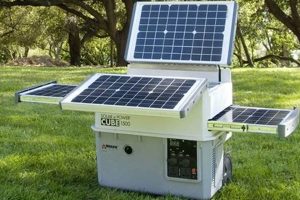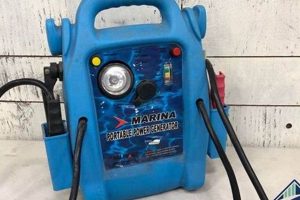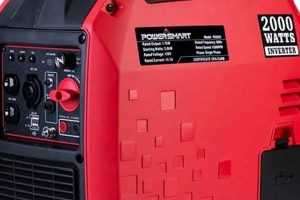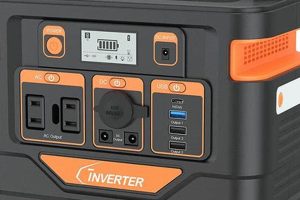A heavy-duty electrical cable designed to carry a substantial current, this connection links a portable electricity-producing device to appliances or a distribution panel. Typically featuring a NEMA 14-50 plug and connector, it facilitates the transfer of significant electrical power, enabling the operation of high-demand equipment like RVs, welders, or multiple devices simultaneously.
This robust connection plays a vital role in ensuring safe and reliable power delivery from a portable power source to demanding applications. Historically, as portable generators became increasingly powerful and capable of supplying higher currents, the need for robust cabling became apparent. These specialized cables minimize energy loss and prevent overheating, safeguarding both the generator and connected devices. This ability to safely harness substantial power makes these connections essential for various purposes, from emergency home power to powering job sites and recreational activities.
Further exploration will delve into selecting the appropriate cable length and gauge, safety considerations, proper usage, and maintenance best practices.
Safe and Effective Cable Usage Tips
Ensuring optimal performance and safety when utilizing a high-amperage power delivery system requires careful attention to several key practices. These guidelines aim to mitigate potential risks and maximize the efficiency of power transfer.
Tip 1: Gauge Selection is Crucial: Cable gauge directly impacts current-carrying capacity. An undersized cable can overheat, posing fire hazards. Consult generator specifications and load requirements to determine the appropriate gauge. Oversizing, while not a safety concern, can lead to unnecessary expense.
Tip 2: Length Matters: Longer cables introduce voltage drop, potentially affecting appliance performance. Minimize cable length whenever feasible and consider heavier gauges for longer runs to compensate for voltage loss.
Tip 3: Inspect Regularly: Before each use, examine the cable for damage such as cuts, abrasions, or exposed wires. Damaged cables should be replaced immediately to prevent electrical hazards.
Tip 4: Proper Connection is Essential: Ensure secure connections at both the generator outlet and the device inlet. Loose connections can cause overheating and potential arcing.
Tip 5: Dry Storage is Key: Store cables in a dry location away from moisture and extreme temperatures. Moisture can corrode connectors and compromise insulation.
Tip 6: Avoid Overloading: Never exceed the generator’s rated output capacity. Overloading can damage the generator and the cable, leading to potential safety risks.
Tip 7: Grounding is Non-Negotiable: Always ensure the generator and connected devices are properly grounded to prevent electrical shocks.
Adhering to these guidelines will ensure safe and efficient power delivery, prolonging the lifespan of equipment and minimizing the risk of incidents. These practices contribute significantly to the reliable operation of power systems under various conditions.
By understanding and implementing these guidelines, users can maximize the benefits of portable power solutions while prioritizing safety.
1. Amperage Capacity
Amperage capacity represents a critical parameter when considering power delivery systems, particularly for portable generators. It defines the maximum electrical current a conductor can safely carry. Understanding this concept is fundamental for selecting the appropriate power cord for a 50-amp portable generator, ensuring safe and efficient operation.
- Current Carrying Limit
A cable’s amperage capacity dictates its safe operational limit. Exceeding this limit leads to overheating, potentially causing insulation damage, fire hazards, and equipment malfunction. A 50-amp power cord is specifically designed to handle up to 50 amperes, making it suitable for generators with this output rating. Using a cord with a lower amperage rating with a 50-amp generator would be unsafe.
- Conductor Size (Gauge)
Amperage capacity is directly proportional to conductor size (gauge). Lower gauge numbers indicate thicker wires with higher current-carrying capabilities. For example, a 6 AWG cable has a higher capacity than a 10 AWG cable. Selecting the correct gauge for a 50-amp power cord is crucial to avoid overheating and ensure efficient power delivery. This typically requires a 6 AWG cable or larger.
- Generator Compatibility
Matching the power cord’s amperage capacity to the generator’s output is paramount. A 50-amp generator necessitates a 50-amp power cord. Using an undersized cord can damage both the generator and connected appliances. Conversely, an oversized cord, while not inherently dangerous, represents unnecessary cost and bulk.
- Load Requirements
The combined amperage draw of all devices connected to the generator must not exceed the power cord’s capacity. Calculating the total load helps determine whether a 50-amp cord is sufficient or if a higher capacity is required. For instance, running a large RV air conditioner and other appliances simultaneously might necessitate a higher capacity cord and generator.
In conclusion, selecting a power cord with the correct amperage capacity is essential for the safe and efficient operation of a 50-amp portable generator. Careful consideration of the generator’s output, the connected load, and the cable’s gauge ensures reliable power delivery and prevents potential hazards. Ignoring these critical aspects can lead to equipment damage, fire risks, and compromised performance.
2. Cable Gauge (Thickness)
Cable gauge, a numerical representation of a conductor’s diameter, plays a crucial role in the safe and efficient operation of a 50 amp power cord for portable generators. Selecting the correct gauge ensures adequate current-carrying capacity, preventing overheating and potential hazards. This discussion explores the relationship between cable gauge and 50 amp power cords, highlighting its practical implications.
- Current-Carrying Capacity
Cable gauge directly correlates to current-carrying capacity. Lower gauge numbers signify thicker conductors capable of handling higher currents. A 50 amp power cord typically requires a 6 AWG gauge or larger to safely accommodate the substantial current flow. Using a smaller gauge, like 10 AWG, with a 50 amp generator can lead to dangerous overheating due to exceeding the cable’s capacity.
- Voltage Drop and Length
Voltage drop, the reduction in voltage along a cable’s length, becomes more pronounced with thinner gauges and longer distances. For 50 amp power cords, especially in longer runs, selecting a lower gauge (thicker cable) mitigates voltage drop, ensuring optimal appliance performance. A 10 AWG cable experiencing a significant voltage drop could result in appliances not functioning correctly. This necessitates careful consideration of both gauge and length when selecting a 50 amp power cord.
- Heat Dissipation
Thicker cables, with lower gauge numbers, dissipate heat more effectively than thinner cables. This characteristic is essential for 50 amp power cords due to the higher currents involved. Effective heat dissipation prevents overheating, reducing fire risks and prolonging cable lifespan. A thinner gauge cable, like 12 AWG, would likely overheat if used with a 50 amp generator, posing a significant safety hazard.
- Safety and Compliance
Adhering to appropriate cable gauge guidelines for 50 amp power cords is crucial for safety and compliance with electrical codes. Using undersized cables poses a significant fire risk due to overheating. Consulting electrical codes and generator manufacturer recommendations ensures the selected cable gauge meets safety standards. For instance, using a 14 AWG cable with a 50 amp generator would violate safety standards and pose a serious risk.
In summary, understanding the relationship between cable gauge and 50 amp power cords is fundamental for safe and reliable operation. Selecting the correct gauge, often 6 AWG or larger, ensures adequate current carrying capacity, minimizes voltage drop, facilitates effective heat dissipation, and promotes compliance with safety standards. Failure to consider these factors can result in hazardous conditions, equipment damage, and compromised performance.
3. Connector Type (NEMA 14-50)
NEMA 14-50 connectors are the industry standard for 50-amp portable generators, facilitating a secure and reliable connection between the power source and high-demand applications. This four-prong connector, comprising two hot wires, a neutral wire, and a ground wire, is specifically designed to handle the substantial current required by devices like RVs, welders, and construction equipment. Using an incorrect connector type can lead to compatibility issues, potentially damaging the generator or the connected devices. For instance, attempting to use a NEMA TT-30 connector, commonly used for RVs with 30-amp service, with a 50-amp generator could result in insufficient power delivery or even electrical hazards due to the connector’s lower current rating. Choosing the correct NEMA 14-50 connector is paramount for safe and efficient operation.
The NEMA 14-50 connector’s robust construction and four-prong design contribute significantly to its safety and reliability. The dedicated ground wire provides essential protection against electrical shocks, while the separate hot wires allow for balanced power delivery. This design minimizes the risk of overheating and ensures efficient operation of connected appliances. Furthermore, the standardized configuration of the NEMA 14-50 connector ensures compatibility with various 50-amp devices, simplifying connection procedures. Consider a scenario where a homeowner needs to power essential appliances during a power outage using their 50-amp portable generator. The NEMA 14-50 connector on the generator’s power cord allows for seamless connection to a transfer switch or inlet box equipped with a corresponding NEMA 14-50 receptacle, enabling safe and reliable power delivery to the home’s electrical system.
Utilizing the correct NEMA 14-50 connector is crucial for maximizing the performance and safety of 50-amp portable generators. Selecting incompatible connectors can lead to operational issues, power delivery failures, and potential electrical hazards. Understanding this connection is paramount for anyone operating high-power electrical equipment. Correct connector usage ensures efficient power transfer and contributes significantly to overall electrical safety. Neglecting this critical aspect can compromise both the generator and the connected devices, potentially leading to costly repairs or safety incidents. Therefore, verifying the correct NEMA configuration, in this case, the 14-50, is a fundamental step in establishing a safe and functional power connection.
4. Length Considerations
Cable length is a critical factor influencing the performance and safety of a 50 amp power cord used with portable generators. Selecting an appropriate length involves balancing practicality with the potential for voltage drop, a phenomenon that can impact the efficiency and safety of power delivery. Understanding the implications of cable length is essential for optimal generator operation.
- Voltage Drop
Voltage drop, the decrease in voltage along a conductor, is directly proportional to cable length and current. Longer cables, especially with higher currents like those used with 50 amp generators, experience more significant voltage drops. This can lead to reduced appliance performance, overheating, and potential damage to sensitive electronics. For instance, a 100-foot 6 AWG cable powering a 50-amp RV air conditioner might experience enough voltage drop to prevent the unit from starting or cause it to run inefficiently. Shorter cables mitigate this issue.
- Practicality and Maneuverability
While shorter cables minimize voltage drop, practical considerations often necessitate longer lengths. Sufficient length is required to reach the power source while allowing for safe and convenient equipment placement. For example, positioning a generator away from a campsite requires a longer cable to reach the RV’s power inlet. However, excessively long cables can be cumbersome and pose tripping hazards. A balance must be struck between minimizing voltage drop and ensuring practical usability.
- Cable Gauge Compensation
The impact of length on voltage drop can be mitigated by increasing cable gauge (using a thicker cable). While a longer cable might be necessary, a thicker gauge can compensate for the increased resistance. For instance, if a 100-foot cable is required, using a 4 AWG gauge instead of a 6 AWG gauge can help maintain acceptable voltage levels. This, however, increases cost and cable weight.
- Cable Management and Storage
Longer cables require more careful management to prevent tangling, damage, and tripping hazards. Proper storage is equally important to protect the cable from moisture, UV exposure, and physical damage. Well-organized storage also simplifies deployment and retrieval. For instance, using a cable reel can significantly improve cable management and prolong its lifespan.
Careful consideration of cable length is essential when selecting a 50 amp power cord for a portable generator. Balancing voltage drop concerns with practical requirements ensures efficient power delivery and safe operation. Ignoring length implications can lead to reduced appliance performance, equipment damage, and potential safety hazards. Understanding the interplay between cable length, gauge, and voltage drop empowers users to make informed decisions that optimize their power systems.
5. Durability and Safety
Durability and safety are paramount considerations for 50 amp power cords used with portable generators. These high-capacity power delivery systems operate under demanding conditions, necessitating robust construction and adherence to safety standards. A cord’s ability to withstand wear and tear directly impacts its operational lifespan and the safety of users and connected equipment. This discussion explores the critical facets of durability and safety in the context of these specialized power cords.
- Robust Construction and Material Quality
High-quality materials and robust construction are essential for withstanding the rigors of outdoor use, frequent handling, and exposure to various environmental conditions. Durable outer jackets, reinforced stress points, and high-grade copper conductors contribute to a cable’s ability to resist abrasion, cuts, and impacts. For example, a cord with a thick, UV-resistant jacket will be less susceptible to cracking and degradation from sunlight exposure compared to a cord with a thinner, less durable jacket. This directly translates to a longer lifespan and reduced risk of electrical hazards.
- Weather Resistance
Outdoor applications expose power cords to various weather conditions, including rain, snow, and extreme temperatures. Weather-resistant materials and construction are essential to prevent water ingress, corrosion, and insulation breakdown. For instance, a fully sealed and waterproof connector prevents moisture from entering the electrical contacts, reducing the risk of short circuits and corrosion. This protection is critical for maintaining safe and reliable power delivery in challenging environments.
- Strain Relief and Connector Integrity
Strain relief mechanisms at the connector ends protect the cable from bending and flexing, which can weaken the connection over time. Robust connectors, securely attached to the cable, are critical for preventing accidental disconnection and maintaining a consistent electrical flow. For example, a molded strain relief boot provides added protection against bending stresses at the connector, reducing the risk of wire breakage and ensuring a secure connection. This contributes significantly to long-term reliability.
- Adherence to Safety Standards
Compliance with industry standards, such as those set by NEMA and UL, ensures the cable meets specific safety requirements. These standards dictate construction parameters, material specifications, and testing procedures to ensure safe operation under various conditions. For instance, a UL-listed cable undergoes rigorous testing to verify its ability to withstand specified current loads, temperatures, and environmental stresses. This certification provides assurance of safety and reliability.
The durability and safety of a 50 amp power cord are integral to its performance and the safety of users and equipment. Investing in a high-quality, durable cord designed for demanding applications ensures reliable power delivery, minimizes risks, and contributes to the overall longevity of the power system. Failing to prioritize these aspects can lead to premature cable failure, electrical hazards, and compromised performance, potentially resulting in costly repairs or safety incidents. Therefore, selecting a durable and safe 50 amp power cord is a critical investment for any portable generator application.
6. Generator Compatibility
Generator compatibility is a critical aspect of selecting and using a 50 amp power cord. A mismatch between the generator’s output capacity and the power cord’s specifications can lead to several detrimental outcomes, ranging from inefficient operation to severe safety hazards. Portable generators vary in their power output, and using a 50 amp power cord with a generator that doesn’t support this amperage can overload the generator, potentially causing damage to its internal components. Conversely, using an undersized power cord with a 50 amp generator can cause the cord to overheat, creating a fire risk. Consider a scenario where a 30 amp generator is connected using a 50 amp power cord. The generator might become overloaded if the connected load approaches 30 amps, as the cord, rated for 50 amps, doesn’t protect the generator from exceeding its capacity. This can lead to generator damage or even fire.
Understanding the generator’s power output, measured in watts or kilowatts, is crucial. This output dictates the maximum amperage the generator can safely supply. A 50 amp power cord is suitable for generators capable of delivering 50 amps at the required voltage. Using a 50 amp cord with a generator rated for lower amperage, such as 30 amps, does not increase the generator’s capacity. It merely creates a potentially hazardous situation where the cord’s higher rating masks the generator’s limitations. For instance, if a generator is rated for 3500 running watts at 120 volts, it translates to approximately 29 amps. Using a 50 amp power cord won’t magically increase the generator’s capacity; it just means the cord itself won’t overheat at lower loads, but the generator still could. This underscores the importance of matching the cord to the generator’s output, not just the desired load.
Ensuring generator compatibility involves careful consideration of both the generator’s specifications and the intended application. Using a 50 amp power cord requires a generator explicitly designed to handle 50 amps. This information is typically found on the generator’s data plate or in the owner’s manual. Attempting to “upgrade” a lower-amperage generator with a 50 amp cord creates a false sense of security and potentially dangerous conditions. Correctly matching the power cord to the generator’s output ensures safe and efficient operation, prevents equipment damage, and mitigates potential fire hazards. Overlooking generator compatibility compromises safety and can lead to costly repairs or even hazardous incidents. Therefore, careful attention to generator specifications is essential for responsible and safe portable generator operation.
Frequently Asked Questions
This section addresses common inquiries regarding 50 amp power cords for portable generators, providing concise and informative responses to clarify potential uncertainties and promote safe usage practices.
Question 1: What gauge wire is required for a 50 amp generator cord?
A 6 AWG (American Wire Gauge) or larger wire is typically recommended for 50 amp generator cords to safely handle the current. Using a smaller gauge risks overheating.
Question 2: Can any 50 amp cord be used with a portable generator?
No. The cord must be specifically designed for generator use and feature the correct NEMA 14-50 connectors for compatibility and safety. Standard 50 amp appliance cords may not be suitable.
Question 3: How does cord length affect generator performance?
Longer cords can lead to voltage drop, reducing power delivered to appliances. This is particularly noticeable with higher loads. Thicker gauge wires and shorter cord lengths mitigate voltage drop.
Question 4: Are there safety considerations specific to 50 amp generator cords?
Yes. Always inspect the cord for damage before each use. Ensure proper connection and grounding to prevent electrical hazards. Never overload the generator or exceed the cord’s rated capacity.
Question 5: What type of connector is used for a 50 amp generator cord?
A NEMA 14-50 connector is the standard for 50 amp generator cords. This four-prong connector (two hot, one neutral, one ground) is designed for high-current applications.
Question 6: How can one ensure proper maintenance of a 50 amp generator cord?
Regular inspection for damage is crucial. Store the cord in a dry location away from extreme temperatures and sunlight. Proper coiling prevents tangling and damage during storage.
Careful consideration of these frequently asked questions promotes a comprehensive understanding of 50 amp power cords for portable generators. Adhering to safety guidelines and selecting appropriate components ensures efficient and reliable operation.
The following section provides further details on specific applications and advanced considerations related to portable generator power cords.
50 Amp Power Cord for Portable Generator
Safe and efficient power delivery from portable generators necessitates careful consideration of the entire power system, including the critical role of the 50 amp power cord. This exploration has highlighted the importance of proper cable gauge selection, connector compatibility (NEMA 14-50), length considerations in relation to voltage drop, and the paramount aspects of durability and generator compatibility. Understanding these elements is fundamental for preventing hazards, ensuring reliable operation, and maximizing the lifespan of both the generator and connected equipment. Overlooking these critical details can lead to inefficient power delivery, equipment damage, and potentially dangerous situations.
Harnessing the full potential of portable generators requires a commitment to informed decision-making and adherence to safety best practices. Appropriate cable selection, meticulous maintenance, and a thorough understanding of load requirements contribute significantly to safe and reliable power delivery in diverse applications. Continued emphasis on safety consciousness and adherence to established standards will remain crucial for maximizing the benefits of portable power solutions while mitigating potential risks.






